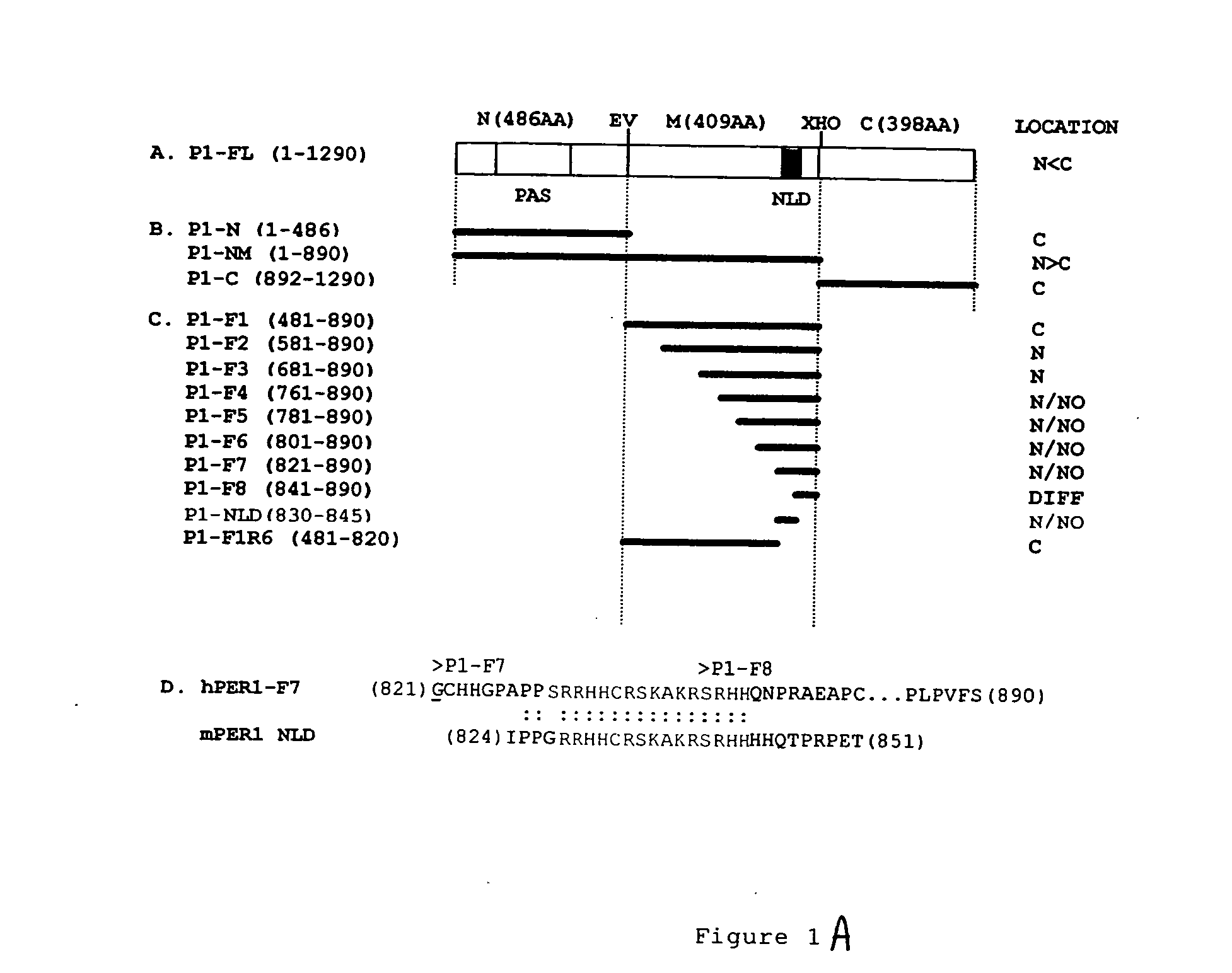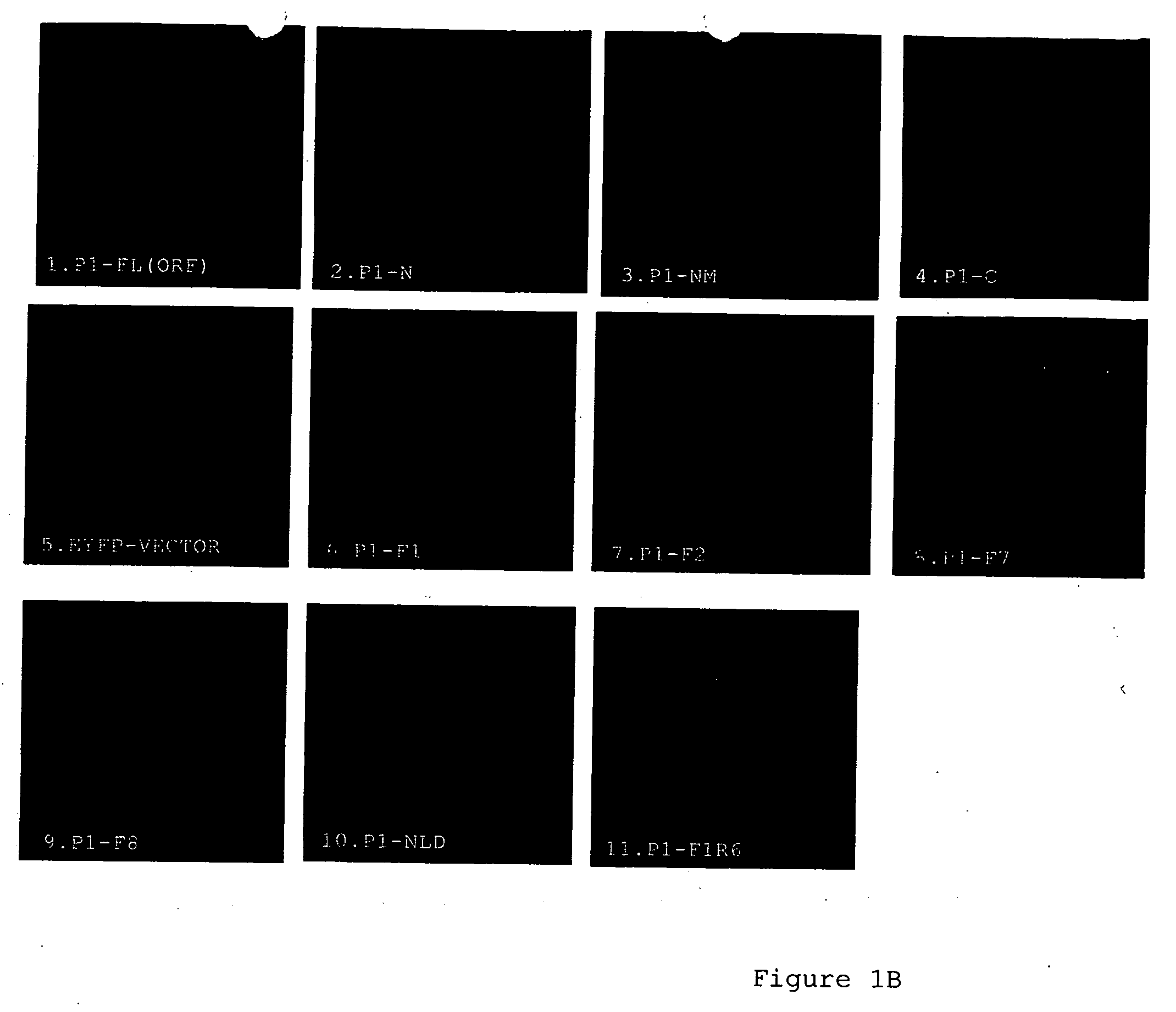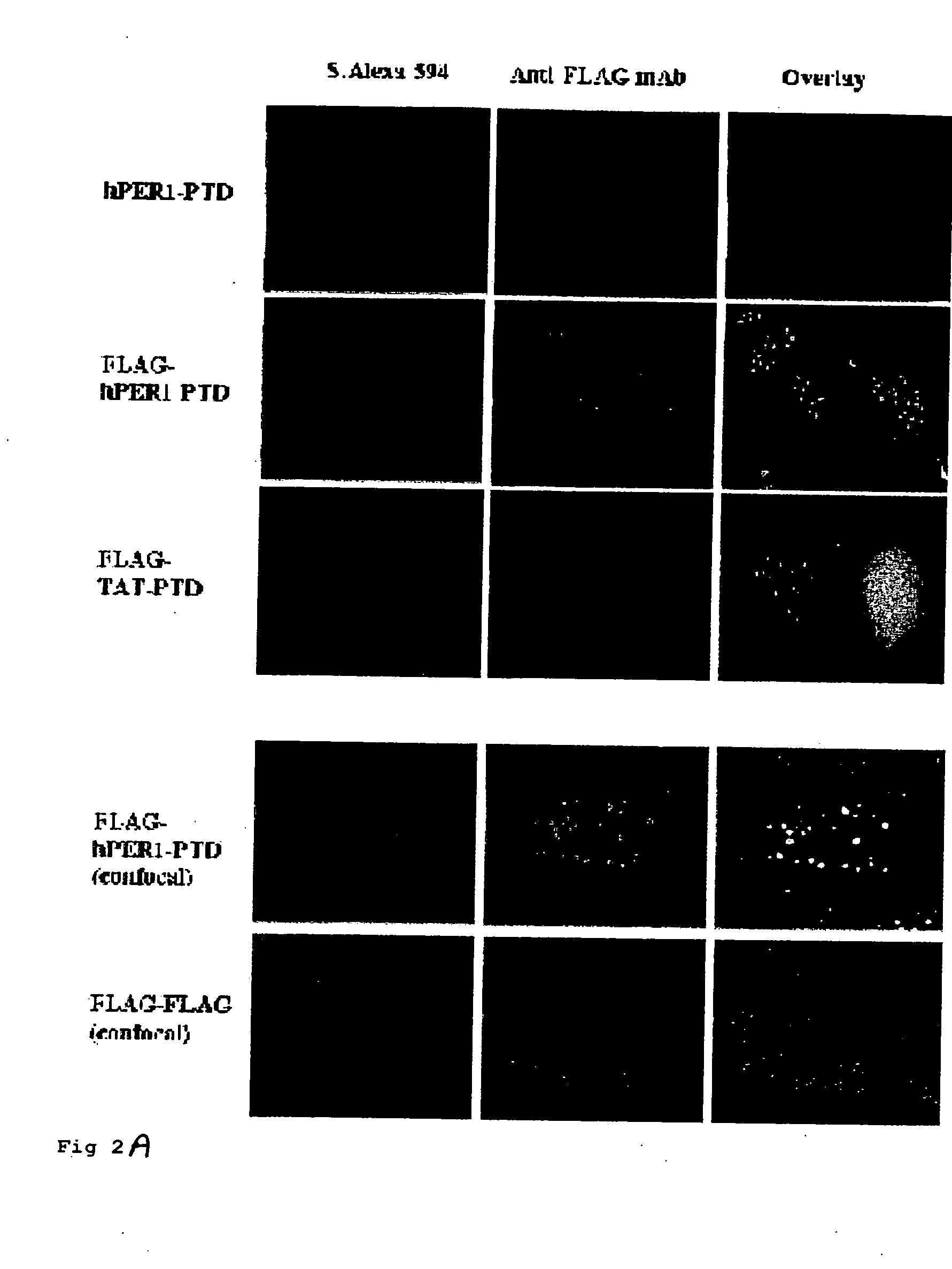Membrane penetrating peptides and uses thereof
a membrane-penetrant and peptide technology, applied in the field of membrane-penetration peptides, can solve the problems of sporadic and weak beta-gal activity in a limited number of tissues, resistance to protease, mitogenic activity, and affinity for the transmembrane receptor, and it has not been established whether they use the same atypical transport mechanism
- Summary
- Abstract
- Description
- Claims
- Application Information
AI Technical Summary
Benefits of technology
Problems solved by technology
Method used
Image
Examples
example 1
Identification of an NLS within hPER1
[0088] Plasmid Construction
[0089] All hPer1 fragments described here are cloned as in-frame C-terminal fusion to EYFP. EYFP-hPer1 ORF, P1-N and P1-NX (FIG. 1A) is generated by insertion of EcoRI and XhoI digested fragments into EYFP-C1 vector (Clontech). The other fragments are PCR amplified from the full-length hPer1 cD)NA and subcloned into EYFP-C1 vector. The first and the last residue present in each of fragment is indicated in FIG. 1A. All constructs are verified by automated DNA sequencing.
[0090] Cell Culture and DNA Transfection
[0091] CHO, HeLa and 293T cells are maintained in Dulbecco's Modified Eagle's Medium (DMEM) supplemented with 10% fetal calf serum (FCS), 50 units / ml penicillin, 50 μg streptomycin, and 4 mM L-glutamine (hereafter referred to as complete DMEM) at 37° C. with 5% CO2. Transfection of the cells is carried in two-well Lab-Tek coverslips (Nunc Inc.) with LIPOFECT-AMINETM™ Reagent (Life Technologies) according to the ...
example 2
hPER1-NLS encodes an MPP
[0098] Two common features of the three identified gene encoded MPPs (TAT, Antp, and VP22) are that they are derived from nuclear proteins and they consist of basic amino acid residues (Lindgren, M., et al., Trends Pharmacol Sci. 3, 99-103 (2000)). hPER1 is also a nuclear protein whose NLS is rich in basic amino acids (SRRHHCRSKAKRSRHH, see FIG. 1). These similarities led us to determine whether hPER-NLS might also function as a MPP. In order to test this hypothesis, we synthesized several N-terminally biotinylated peptides: hPER1-MPP, Flag-tagged hPER1-MPP, Flag-tagged TAT-PTD, Flag-Flag alone, See Table 1 below:
TABLE 1NuclearLocalizationTransducingFusionNameAmino Acid SequencePeptide1Protein2hPER1GRRHHCRSKAKRSRHH++Flag-hPER1GMDYKDDDDKGSRRHHCRSK+ndAKRSHHFlag-TATGMDYKDDDDKGYGRKKKRR++QRRRFlagGMDYKDDDDKG−−MDYKDDDDKAntennapediaGRQIKIWFQNRRMKWKK+nd9 ArginineGPRRRRRRRR+nd9 LysineGKKKKKKKKK+nd9 HistidineGHHHHHHHHH−ndNLSs:SV40GDPKKKRKV−+hPER2GKKTGKNRKLKSKRVKPRD−+...
example 3
Arginine 7 is Essential for hPER1-MPP Activity
[0102] To date, the mechanisms as well as the structural basis whereby MPPs transverse cellular membranes have not been elucidated. We therefore sought to determine if there were key residues within hPER1-MPP that were important for maintaining those properties essential for its membrane penetrating potential. We separately replaced each amino acid in hPER1-MPP to alanine (Table 2), and assayed for the ability of these mutated peptides to penetrate living cells relative to the wild-type hPER1-MPP.
[0103] Alanine scaning:
TransducingNamehPER1-PTD alanine substitutionPeptidehPER1-S R R H H C R S K A K R S R H H+PTDR2AS A R H H C R S K A K R S R H H+R3AS R A H H C R S K A K R S R H H+H4AS R R A H C R S K A K R S R H H+H5AS R R H A C R S K A K R S R H H+C6AS R R H H A R S K A K R S R H H+R7AS R R H H C A S K A K R S R H H−S8AS R R H H C R A K A K R S R H H+K9AS R R H H C R S A A K R S R H H+K11AS R R H H C R S K A A R S R H H+R12AS R R H H...
PUM
| Property | Measurement | Unit |
|---|---|---|
| concentration | aaaaa | aaaaa |
| hydrophobic | aaaaa | aaaaa |
| conformational changes | aaaaa | aaaaa |
Abstract
Description
Claims
Application Information
 Login to View More
Login to View More - R&D
- Intellectual Property
- Life Sciences
- Materials
- Tech Scout
- Unparalleled Data Quality
- Higher Quality Content
- 60% Fewer Hallucinations
Browse by: Latest US Patents, China's latest patents, Technical Efficacy Thesaurus, Application Domain, Technology Topic, Popular Technical Reports.
© 2025 PatSnap. All rights reserved.Legal|Privacy policy|Modern Slavery Act Transparency Statement|Sitemap|About US| Contact US: help@patsnap.com



